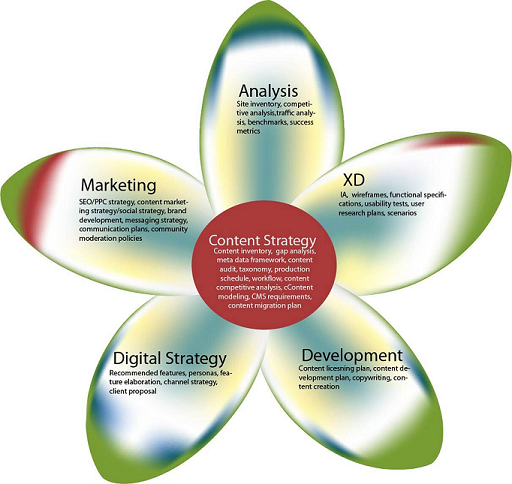I’ve been thinking a lot recently about what content strategy is – to me, to clients and employers, and in the larger XD ecosystem.
We all know the Halverson-approved definition: “Content strategy is the practice of planning for the creation, delivery, and governance of useful, usable content.” The definition is both excellent and not that helpful. Or maybe it is amazingly helpful, as you can decide CS is whatever you need it to be at the time. (This is not a criticism of Kristina Halverson or her book Content Strategy for the Web. Both she and her book are amazing. But still: no two people share a definition of content strategy.)
CS can be as big or as small as you want it to be. In some agencies, content strategy is a fancy title for a web editor. In others, CS is marketing – brand development and messaging strategies. In others, it is content marketing… or copywriting… or almost anything else that it remotely related to words.
Here’s a job description from a recent client:
The ideal candidate will:
- Collaborate with interactive team to research and design sites for clients
- Drive concept development including contextual inquiries, persona and scenario development, and ideation
- Work with engineering to use research findings and other sources to prioritize, develop, and refine product requirements
- Put yourself in the shows of the end user in regards to design and development
- Previous copywriting experience a plus
Here’s another:
- Brainstorms and pitches content ideas internally and to clients
- Strategize and implement content distribution and promotion plans
- Manage timelines, deliverables, and related process documents
- Participates in content marketing related client calls and presents strategies and deliverables
- Develops methodologies and presents reports that assess content marketing program successes and takeaways
- Manages activities with key partner
And another:
- Outstanding writing skills.
- Ability to design narrative strategies across multi-channel digital environment so users experience a compelling, consistent story no matter where they access content.
- Ability to clearly define and prioritize content goals at the outset of a project and ensure those goals are executed by members of the editorial team.
- Ability to manage all editorial development cycles of a project, from initial concepts to copy reviews to UAT, ensuring content team delivers solutions on time and on budget.
- Experience leading client discovery workshops and quickly digging into the research details to create strong user-centered strategic insights.
Folks, I gotta tell you: those are different jobs. The fact that they are different is only a problem if you are jumping into one, and it is a different flavor of content strategy than you’d hoped.
So, let’s look at it from the perspective of key deliverables:
No matter how liberally you approach the comparison of deliverables, you have to concede these are very different lists. (Deliverables in bold are on both lists.) Kissane’s list (from her must-read The Elements of Content Strategy) is much broader than Halverson’s and includes activities often found in digital strategy, UX, and social marketing departments. The shared deliverables are often the core of any content strategy practice. But tasks that the actual content strategist undertakes tasks often bleed into other areas. Because content strategy is poorly understood (and content strategists are so well rounded!) specific content strategy jobs often start where other disciplines end. If the team lacks UX help, content strategists become UX designers. If the team needs marketing guidance, they look to the content strategist. (Marketing does, after all, usually involve words.)
It is precisely the broad definition frequently given content strategy that makes it so compelling to me. But lack of a consistent definition is also a problem. If you are used to playing the role of UX-er and are suddenly dropped into a place with a strong UX team, you may be surprised to find yourself unceremoniously shoved out of “their” space. (I’ve had more than one PM tell me, after I’ve delivered a content production plan, that schedule development is his job.)
What the content strategy discipline needs is a new framework, one that takes into account the variety of responsibilities that a content strategist might encounter. A framework that helps us talk about our skills and interests and understand how we might fit into a client or employer’s organization given their needs and strengths. And so, I propose the flower:
Content Strategy as a Flower

Content Strategy as a Flower
Content Strategy is the classic T-shaped discipline. While there are a core set of responsibilities that belong to CS alone, CS-ers often specialize in one or more additional disciplines, and are able to provide expert direction in those areas when the client requires it. So one content strategist has, by virtue of client needs and individual specialization, a significantly different job from another content strategist. And while many content strategists have broad enough skills to pitch hit in these categories when needed, there are core tasks in each discipline that are outside the daily expression of skills of most content strategists. (Once again, one of those ubiquitous Venn diagrams.)
So when you are talking to a client or potential employer, don’t stop probing when they say they need “content strategy.” Content strategy is only the beginning of the discussion. Work with them to define what they mean by content strategy. Do they want the marketing CS flavor or the XD CS flavor? Pick a petal or two. (Petals are much prettier than buckets.)

